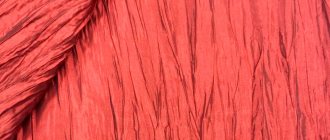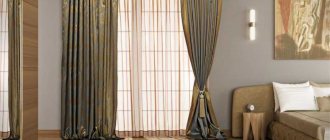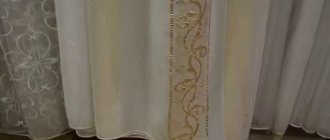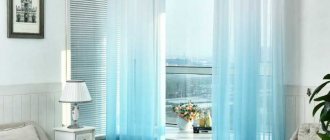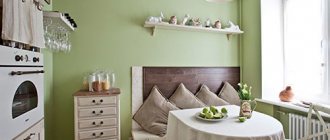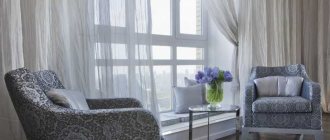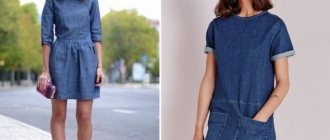Legend of the Veil
The first translucent curtains were made from veils. Initially, this was not the name of an item of clothing for the bride, but a thin fabric that was used to cover the girls’ heads. According to legend, when one of the French kings was getting married, the bride asked him to order a fabric through which she could see everything, and her face would be hidden from onlookers.
The girl was very shy and did not want ordinary people to look at her like an animal in a circus. The groom fulfilled her request, and after a while the fabric began to be used so that passers-by would not look into the windows, and light would freely penetrate into the house.
The French liked the new-fashioned decoration so much that curtains made of fine fabric began to be hung on windows everywhere. Later, other types of curtain material appeared, but they were all translucent and very light.
How to cover a window in the kitchen
Traditionally, curtains and tulle are used to decorate windows and to hide what is happening in the house from prying eyes. If the kitchen cannot boast of a location on the south side of the house or a large panoramic window, thick curtains, even in light shades, will take away too much of this valuable sunlight. Then all that remains is to hang the tulle on the kitchen window.
Photos and original ideas for decorating windows in the kitchen can be searched on the World Wide Web, but before deciding on a design, you need to study all the features of your kitchen, familiarize yourself with the variety of kitchen curtains and the criteria that decorative elements must meet.
Varieties of curtain lengths
The length of the curtains is a factor on which the visual perception of the curtain largely depends. This parameter is individual; there are no generally accepted design standards about how long curtains should be - it all depends solely on personal taste and wishes. We offer you the most common curtain length options, which you can use as a basis when implementing your own ideas.
There are five popular size options for decorative curtains:
- Curtains up to the window sill are a laconic solution that is used when decorating windows in kitchens and bathrooms. In this case, the size of the panel is calculated so that there is 1-1.5 centimeters of free space between the fabric and the window sill. Visually, such curtains look restrained; to decorate them, it makes sense to use additional decorative elements - lambrequins, holders, tulle.
- Below the window sill - the length of the panel is 10-12 centimeters greater than the height of the window opening. This is a more elegant option, it is perfect for kitchens where the windows are located away from the gas stove;
- From the floor - in this case, the curtain rises above the floor surface at a height of 5-6 centimeters, which is the most universal and common solution. The only drawback is the visual reduction in the height of the walls; in rooms with low ceilings (up to 2 meters) it is better not to use curtains of this length;
- Floor-length curtains are a classic option that will look appropriate in any interior. The height of the panel should be located at a level of 1-1.5 centimeters above the floor surface. When implementing this approach, take measurements with special care; even the slightest differences in the height of the floor and ceiling must be taken into account. If the measurements are taken incorrectly, the curtain may have an overlap on one side, and on the other, on the contrary, rise above the floor at a greater height than necessary;
- Curtains on the floor - the height of these products should be such that a 10-30 centimeter section of fabric lies on the floor.
Choosing matter
Previously, tulle was not called curtains, but a thin mesh material with a pattern. Window curtains were most often made from it. Nowadays, it is customary to call tulle long or short curtains made from thin fabric.
Modern natural and artificial materials provide a wide choice for sewing curtains. The main thing to remember when choosing curtains and tulle for the kitchen is that they should be made of smooth, lint-free material.
The fabric should be easy to wash, because... During the cooking process, soot and excess moisture will still settle on it. Modern tulle can be made from mesh, chiffon, organza, muslin or veil.
Current colors for tulle
When choosing a color scheme for tulle design in the kitchen, you should start from modern trends.
This year, in addition to classic calm tones, designers advise choosing red and yellow tulles. Colors can be either pure and bright or more muted. When choosing such rich colors, the main thing is to correctly fit them into the overall tone of your kitchen.
Black and white classics are not losing ground either. If everything is clear with white, then many are afraid to hang dark gray or black tulle in the kitchen. Yes, for a small room it will most likely be inappropriate, but if your house has a large kitchen, dark tulle will help emphasize the originality of, for example, a high-tech style. If you are afraid of black tulle, choose chocolate or gray shades.
In 2021, home textile designers suggest experimenting with color mixing. Combining two colors that are similar in temperature will add a touch of freshness to your curtains and give a more modern look to your kitchen overall.
The bravest of you can try curtains with floral or even animal prints on your windows, but in such decisions you need to be very careful and combine them exclusively with a minimalist interior. In general, if you really want printed curtains in the kitchen, first look for a photo of such tulle for the kitchen or contact an experienced designer.
Kitchen design with tulle
Interior design presupposes the existence of fashion trends, which are always reflected in the styles of tulle and curtains for the kitchen. Designers are developing special styles and accessories that meet modern requirements. So, when decorating the interior, you can combine tulle and kitchen curtains made of dense materials.
If it is difficult to decide on the color of tulle, then you can safely choose fabric in light colors - white, beige, gray. In this case, it is important to build on the color of the kitchen furniture and the shade of the wall cladding in the room. If the kitchen is equipped with a set of wood, then a tulle mesh would be an ideal decoration for the window.
A short tulle arch is also suitable for a small room, since it takes up virtually no space. The accessibility of the window sill allows you to place kitchen utensils on it. Fashionable fabrics are satin and velor; in some cases, artificial leather is used. For tulle combined with dense fabric, it is necessary to provide appropriate care.
Classic tulle must be of high quality. It consists of 2 curtains located on 2 sides of the window. This design is not suitable for a small kitchen, despite its lightness and airiness. In large rooms, tulle curtains can not only be combined with thicker curtains, but also fill the entire space of the window opening with them. The kitchen becomes more cozy and comfortable.
The smaller the kitchen area, the lighter and simpler the design of tulle curtains should be. The product should not be decorated with large patterns, draperies, glitter, volume or colorful decor. The color of the fabric should be light. For example, white tulle is the most commonly used color. This fabric is available in a fairly wide range.
You may also be interested in: Rules for choosing roller blinds for the kitchen
The use of combined textile decor options in kitchens involves combining various types of curtains with tulle. These can be curtains, Roman blinds with tulle or roller blinds, etc. They not only give a special effect to the design of the room, but also, if necessary, shade it.
Methods of attaching tulle
Now there are several ways to attach tulle, including in the kitchen. When choosing thin curtains up to the length of the window sill, you can attach them to a special fishing line; transparent plastic hooks will slide along it, which cling to the loops of the curtain tape on the tulle.
There are several ways to hang tulle in a kitchen with a balcony door, which will weigh more due to its length.
- On a classic cornice with rings;
- On the ceiling cornice (then it will create the feeling that the tulle is simply floating in the air);
- On the eyelets (in ready-made purchased tulle there are special holes framed by metal rings, the round cornice is threaded directly into these rings and they slide along the cornice);
- Featuring retro style toothed latches.
Length of tulle and curtains
Among the variety of products, there are main groups according to the length of the material:
- Short window sill curtains. The size is calculated taking into account the gap between the end of the fabric and the window sill of 1.5–2 cm. They are often hung together with lambrequins, tulle, etc. If you use dark materials, they will visually “cut up” the space; this is not beneficial for small and low rooms. Flirty curtains in the kitchen, gathered on the sides with grabbers, will create a feeling of playfulness and lightness. They will not interfere with everyday life and will get dirty less;
- The canvas is below the window sill at a distance of 10–20 cm. This option is suitable only for rooms in which the window sill is not used as a usable space and gas and electrical appliances are not located nearby;
- The length from the floor is 5–7 cm. This option is considered the most popular, but it should be taken into account that with such curtains the height of the room is visually reduced. This is especially disadvantageous for apartments with ceilings below 2 meters. A large number of folds in heavy canvases also weighs down the appearance of the window space. In such cases, the tulle is hung evenly with the length of the heavy curtain;
- Floor-length canvas The curtains are located at a distance of 1–1.5 cm from the floor, visually creating the impression of resting on the floor; if the covering is not level, this must be taken into account when taking measurements. In this case, the lack of floor unevenness can be corrected. The fabric is used with a margin or exactly the distance from wall to wall. If there is a stretch ceiling, the nuance lies in the location of the curtain - it can be hidden under the ceiling (then the fabric must be taken with a reserve) or below the ceiling;
- The fabric lies 10–30 cm on the floor. Such options are rarely used due to their rapid contamination and impracticality. During cleaning, they must be lifted, and then carefully laid out. These models look especially good in elegant rooms. They do not require additions in the form of accessories, but independently perform the function of complete decoration.
The difference in the sizes of tulle and curtains can only be in the first option, in the rest they are the same. In option 5, the tulle can be shorter; the length is created by the curtains themselves.
Unusual uses of tulle
In addition to the short and long curtains we are accustomed to, other types of curtains that are fashionable and popular now can also be made from tulle and similar fabrics. For example, roller blinds, Roman and Austrian blinds can also be made from translucent materials.
And artificial fabrics can look very light, but in fact be more durable, which is exactly what is needed for some curtain models. Let's talk about each of them in more detail.
Recommended length of curtains for different rooms: kitchen
The specific length of the panels must be determined based on the functional purpose and overall characteristics (ceiling height, area) of the room.
In kitchen rooms it is rational to use a shortened version of curtains - up to the window sill or slightly lower. This recommendation applies to windows located near the food preparation area, for which Roman and Austrian blinds would be a practical solution. If the kitchen is divided into two zones, then in the dining room you can use floor-length curtains or curtains that rise a few centimeters above its surface.
Important: any curtains, even short ones, if they are located next to the stove, must be equipped with weight strips at the bottom. This way you will protect yourself from the risk of the fabric scattering during ventilation, which could result in the fabric falling into an open fire.
The height of curtains in the kitchen is calculated as follows: measure the distance from the cornice to the window sill and add to it 10 centimeters required to process the outer edges. If you need to lower the curtain below the window sill, add the length of the overlap to the result.
Determine the length of the curtains in the kitchen depending on your wishes
Living room
The living room is a space for implementing extraordinary design solutions. When arranging its interior, you need to try to emphasize the geometry of the space, which helps to do this by choosing the right length of curtains in the living room: in large rooms, floor-length curtains or curtains with a 20-25 centimeter hem look advantageous, while in small rooms you can limit yourself to laconic curtains below window sill.
When giving preference to curtains lying on the floor, keep in mind that such curtains look beautiful only if they are made of light textile materials:
High-density fabrics are not suitable for this, because instead of beautiful folds at the bottom, they form hard creases that can ruin the entire visual appeal of the upper part of the fabric.
Bedroom
Bedrooms traditionally use long curtains to promote an atmosphere of seclusion and privacy. To decorate windows in low rooms, use floor-length curtains; they will visually increase the height of the walls. The resulting effect can be complemented by using panels of pastel and cool shades, which tend to visually expand the space.
If the window in the bedroom is located directly above the bed, give preference to small curtains up to the length of the window sill. Rolled products made from high-density black-out fabrics are well suited here; when closed, they completely prevent sunlight from penetrating into the room.
The correct length of curtains is a compromise concept. After a few years, or even months, even a perfectly chosen curtain will get boring, and you will want to change the window into a new decoration, so don’t be afraid to experiment!
Roman curtains
This type of curtain is a flat piece of fabric, with a plastic or wooden strip inserted at the bottom, and threads stretched along the sides. If it is necessary to raise the curtain, it is pulled by the laces and it rises to the desired level, forming beautiful horizontal folds.
Usually they are sewn from linen, cotton or artificial materials that copy them. But what's stopping you from placing such an ultra-modern curtain on your kitchen window, but making it out of tulle?
Such a curtain will not interfere or be blown away by the wind, even if you hang the tulle in the kitchen with a door (it will be held in place by a special bar), and sunlight will freely enter the room.
Types of tulle for sewing kitchen curtains
When choosing tulle material, you need to ensure that it is of high quality. If the tulle is made of polyamide threads, it quickly breaks down. This happens not only when washing curtains under the influence of synthetic-based detergents, but also under the influence of solar radiation. Ultraviolet radiation causes the polyamide thread to decompose, and the product itself begins to “creep”.
Before choosing a material for curtains in the kitchen, you should remember that the products will have to be washed often. The material used must be durable, not just attractive in appearance. Many experts recommend buying tulle made of polyester (100%), which does not wrinkle, does not turn yellow, and is not subject to the destructive effects of ultraviolet radiation.
Kitchen curtains should not be made from tulle woven from cotton fibers, as they make the product shrink. After the first wash, such curtains will immediately lose their appearance. If you have already decided to sew curtains for the kitchen from cotton, then you need to take it with a reserve. In order for the product to remain the same after shrinkage, it is necessary to make a reserve of 15 cm before sewing it.
The types of tulle according to the type of weaving are as follows:
- mesh;
- organza;
- veil.
The tulle mesh in the kitchen ensures free flow of air into the room from the street. This is a material whose interlacing threads form visible gaps. This type of fabric allows sunlight coming from the window to pass through well.
Tulle organza is an elastic fabric. In the kitchen, curtains made of this material, with a floral or abstract pattern, look very beautiful. Dust that enters the kitchen through an open window does not settle on them. Due to poor air permeability of the material, it is impossible to properly ventilate the room, refreshing it with the curtains drawn. The use of air conditioners and hoods in modern kitchens reduces the significance of this drawback.
You may also be interested in: Choosing tulle for the living room - tips with photos
The smooth veil, made from 100% polyester, is soft and translucent. It is not capable of scattering light and also allowing air to pass through. Voile curtains are not suitable for kitchens in apartments on the lower floors. In the summer it is very difficult to spend time in such a kitchen if the room does not have air conditioning.
Tulle roller blinds
Roller blinds work on the same principle as Roman ones, only the material in them is not folded, but is wound around a round rod, which is located at the bottom of the curtain. The design of such curtains is so simple that you can easily sew such tulle for the kitchen with your own hands.
It will be enough to buy tulle, a couple of cords and pull out a round rod from old blinds, which, by the way, are completely out of fashion and do not look at all out of date on kitchen windows.
Austrian design
This type of curtains can be made either from thick curtain material or from tulle or curtain fabric. They look like a straight piece of fabric that is divided vertically into three parts by two pieces of ribbon or decorative cord. When the cords are tightened, you get a semicircular cut in the middle and two pleated beautiful edges of the curtain.
Austrian curtains look lush and elegant, and thin translucent fabric will give them lightness and modernity. Austrian curtains can be made either short, just below the window sill, or almost to the floor.
Design features of small kitchens
When we are talking about decorating a window opening in a small room, you should still choose tulle in light shades; it will not attract unnecessary attention, and the translucent texture will allow you to visually increase the size of the room.
If the width of the window sill allows, you can convert it into a tabletop. This will help gain a few more centimeters of space, and you can hang a short Roman blind made of tulle on such a window.
How to choose a tulle curtain design
Before purchasing finished fabric, you need to determine the dimensions of its length and width. This is important to do before making curtains with your own hands or when ordering custom tailoring. In order to determine the necessary parameters, it is necessary to use the basic options.
The classic method of determining the length of the future product from the floor to the cornice is appropriate here. Before decorating your kitchen interior with long curtains, you need to imagine the effect of this option. It is ideal for a large room, but for a small kitchen it will not be practical.
You may also be interested in: How to sew tulle curtains yourself
A shorter version is considered more convenient, which also looks beautiful in the kitchen interior. The canvas with this design should be 20 mm longer than the edge of the window sill. To decorate tulle curtains made of organza or cotton, you can use a contrasting border. She sews it with her own hands along the lower edge of the fabric.
Kitchen interior design requires a certain type of curtain model. For example, to decorate a kitchen in Provence style, you can use mesh tulle. Classic or country style requires decorating windows with arched curtain models. This allows you to leave free space not only on the windowsill, but also on the countertop mounted in it.
A special feature of an organza arch is the ability to decorate curtains with folds. You can choose the method of crossing 2 triangular-shaped fabrics or use 2 types of fabric that are similar in texture and color. The tulle arch for the kitchen is made from a color-matching material. This allows you to make the kitchen interior interesting and attractive.
If there is a lot of light in the room, you can focus on dark-colored materials. If the ceiling in the kitchen is too low, then a special striped curtain, as well as muslin, will make it visually higher. It would be appropriate to install a cornice right up to the ceiling. It should be borne in mind that the smaller the window opening, the lighter the tulle should be chosen.
Save
Save
Unusual options
How can you highlight your window among dozens of similar windows on the facade of a multi-story building? That's right, color. Multi-colored tulles have already been mentioned before, but now I would like to mention a relatively new curtain design. We will talk about photo printing.
Modern equipment makes it possible to apply high-quality designs even to very thin and transparent fabrics. This can be any pattern (photo curtains made of tulle with a geometric pattern or a pattern of stripes and dots will look good) or a pattern. Tulle with images of flowers or coffee beans looks good.
The main thing to remember is not to form too many folds on tulle with a photo pattern. Thus, you can greatly distort the image, and all the charm of such a curtain will be lost.
Tulle made from thin strips of fabric will also look interesting. Such a curtain will at least look original and let in even more sunlight.
Whatever type of tulle you choose, this material will always remain relevant. Especially when it comes to decorating kitchen windows. In addition to color and pattern, tulle can be more or less transparent, glossy or matte. Depending on the size of the canvas and the properties of the fabric, consultants from specialized stores will recommend the appropriate cut of tulle curtains that you should choose.
